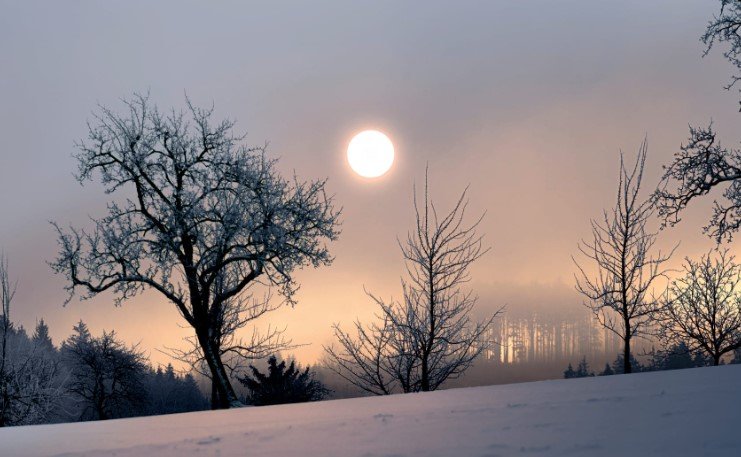The winter solstice is a natural phenomenon that marks the start of winter and the shortest day of the year in the Northern Hemisphere. It occurs when the Earth’s North Pole is tilted the furthest away from the sun, resulting in the least amount of sunlight reaching the surface. In 2023, the winter solstice will happen on Friday, December 22, at 3:27 a.m. GMT. Here are some facts and myths about this astronomical event and how people worldwide celebrate it:

What is the winter solstice, and why does it happen?
The winter solstice is the moment when the sun reaches its lowest point in the sky, as seen from the Northern Hemisphere. This happens because the Earth orbits the Sun on an elliptical path and rotates on an axis tilted by about 23.5 degrees. This means that different parts of the Earth receive different amounts of sunlight throughout the year, creating the seasons.
The winter solstice occurs when the Earth’s North Pole is pointing away from the Sun, making the Northern Hemisphere experience the longest night and the shortest day of the year. The opposite happens in the Southern Hemisphere, where it is the summer solstice and the longest day of the year. The winter solstice also marks the point when the sun begins to move northward again, gradually increasing the daylight hours in the Northern Hemisphere.
How long is the shortest day of the year?
The duration of the shortest day of the year depends on the location’s latitude. The closer to the North Pole, the shorter the day. For example, in London, the shortest day lasts 7 hours, 49 minutes, and 42 seconds, while in Reykjavik, Iceland, it lasts only 4 hours, 7 minutes, and 12 seconds. On the other hand, in Singapore, which is near the equator, the day length is almost constant throughout the year, at about 12 hours.
The actual moment of the winter solstice varies slightly from year to year, depending on the Earth’s orbital motion and the leap year cycle. The winter solstice can occur on any date between December 20 and December 23, but it is most common on December 21 or 22.
How is the winter solstice celebrated around the world?
The winter solstice has been observed and celebrated by various cultures and religions for thousands of years, as it symbolizes the rebirth of the sun and the return of light and warmth. Some of the most famous winter solstice celebrations include:
- Stonehenge: The ancient stone circle in England is aligned with the sunrise and sunset of the winter solstice, attracting thousands of visitors every year who gather to watch the sun rise above the Heel Stone. The site is believed to have been a sacred place of worship and ritual for the prehistoric people who built it.
- Yule: The pagan festival of Yule celebrates the winter solstice as the birth of the Sun God and the beginning of a new cycle of life. It involves lighting candles and bonfires, decorating evergreen trees and wreaths, exchanging gifts, and feasting. Many of the traditions of Yule have been incorporated into the modern celebration of Christmas.
- Dongzhi: The Chinese winter solstice festival, also known as the Extreme of Winter, is a time to honor one’s ancestors and gather with family and friends. It is customary to eat tangyuan, glutinous rice balls with sweet or savory fillings, which symbolize reunion and harmony.
- Inti Raymi: The Inca festival of the Sun God, Inti, was celebrated on the winter solstice in the Southern Hemisphere, which falls in June. It was a lavish ceremony that involved sacrifices, dances, music, and offerings to the Sun. Today, it is reenacted every year in Cusco, Peru, attracting thousands of tourists and locals.
What are some myths and legends associated with the winter solstice?
The winter solstice has inspired many myths and legends throughout history, as people tried to explain the changing seasons and the mysterious movements of the Sun. Some of the most popular stories include:
- The Holly King and the Oak King: In Celtic mythology, the Holly King and the Oak King are two aspects of the same god who engage in a perpetual battle for supremacy. The Holly King represents the dark half of the year, from the summer solstice to the winter solstice, while the Oak King represents the light half of the year, from the winter solstice to the summer solstice. The winter solstice marks the victory of the Oak King over the Holly King and the return of the light.
- The Wild Hunt: In Germanic and Nordic folklore, the Wild Hunt is a ghostly procession of hunters, hounds, horses, and other supernatural beings that roam the sky during the winter solstice. It is said to bring misfortune, death, or abduction to anyone who encounters it or hears its sound. The leader of the Wild Hunt varies in different versions, but it is often associated with Odin, the chief god of Norse mythology.
- The Sun and the Moon: In many cultures, the Sun and the Moon are seen as lovers, siblings, or rivals who chase each other across the sky. The winter solstice is sometimes explained as the time when the Sun and the Moon are reunited after a long separation or when the Sun defeats the Moon in a cosmic battle. The winter solstice is also considered to be a favorable time for romance, fertility, and prosperity.






